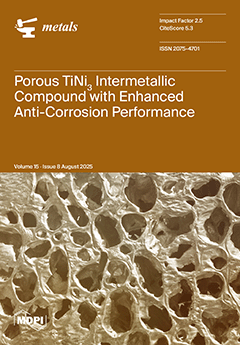Boron (B) is widely used as a neutron-absorbing nuclide and has significant applications in the nuclear industry. B
4C/Al composites combine the high hardness of B
4C with the ductility of Al, making them commonly used neutron-absorbing materials. Under current preparation
[...] Read more.
Boron (B) is widely used as a neutron-absorbing nuclide and has significant applications in the nuclear industry. B
4C/Al composites combine the high hardness of B
4C with the ductility of Al, making them commonly used neutron-absorbing materials. Under current preparation methods, the poor wettability and low reactivity of B
4C with molten Al limit its effective incorporation into the matrix, and the addition of B
4C in B
4C/Al composites has reached its threshold limit, making it difficult to achieve breakthrough improvements in neutron absorption performance. However, incorporating additional B elements into the B
4C/Al composite can break this limit, effectively enhancing the material’s neutron absorption performance. Nevertheless, research on the impact of this addition on the mechanical properties of the composite remains unclear. The requirements for B
4C/Al composites as spent fuel storage and transportation devices include high mechanical strength and certain machinability. This study fabricated B
4C/Al composites with varying B contents (5 wt.%, 10 wt.%, and 15 wt.%), and the influence of B addition on the microstructure and mechanical properties of B
4C/Al composites was investigated. The results demonstrate that the composites exhibit a density of approximately 99% with well-established interfacial bonds. Increasing B content leads to a higher quantity of interfacial reaction products Al
3BC and AlB
2, enhancing the Vickers hardness to 370.93 HV. The bending strength and fracture toughness of composites with 5 wt.% and 15 wt.% B addition decreased, whereas those with 10 wt.% B exhibited excellent resistance to crack growth and high-temperature plastic deformation due to a high content of ductile phase.
Full article





